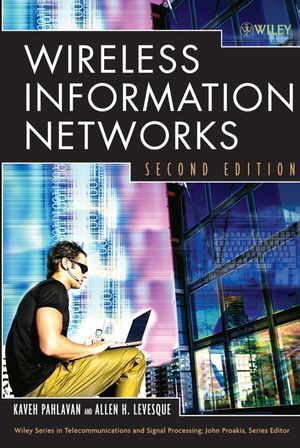Wireless Information Networks, 2nd EditionISBN: 978-0-471-72542-8
Hardcover
768 pages
September 2005
 This is a Print-on-Demand title. It will be printed specifically to fill your order. Please allow an additional 15-20 days delivery time. The book is not returnable.
|
||||||
Preface xi
PART I INTRODUCTION TO WIRELESS NETWORKS 1
1 Overview of Wireless Networks 3
1.1 Introduction, 3
1.2 Network Architecture and Design Issues, 6
1.3 Key Trends in Wireless Networking, 20
1.4 Outline of the Book, 21
Questions, 22
2 Evolution of the Wireless Industry 23
2.1 Introduction, 23
2.2 Three Views of the Wireless Industry, 29
2.3 Three Generations of Cellular Networks, 32
2.4 Trends in Wireless Technologies, 43
Questions, 49
PART II CHARACTERISTICS OF RADIO PROPAGATION 51
3 Characterization of Radio Propagation 53
3.1 Introduction, 53
3.2 Multipath Fading and the Distance–Power Relationship, 55
3.3 Local Movements and Doppler Shift, 64
3.4 Multipath for Wideband Signals, 66
3.5 Classical Uncorrelated Scattering Model, 72
3.6 Indoor and Urban Radio Propagation Modeling, 81
Questions, 86
Problems, 87
Projects, 89
4 Modeling and Simulation of Narrowband Signal Characteristics 93
4.1 Introduction, 93
4.2 Modeling Path Loss and Slow Shadow Fading, 96
4.3 Doppler Spectrum of Fast Envelope Fading, 110
4.4 Statistical Behavior of Fast Envelope Fading, 122
4.5 Simulation of Fast Envelope Fading, 126
Questions, 133
Problems, 134
Projects, 137
5 Measurement of Wideband and UWB Channel Characteristics 149
5.1 Introduction, 149
5.2 Time-Domain Measurement Techniques, 151
5.3 Frequency-Domain Measurement Techniques, 171
5.4 Advances in Frequency-Domain Channel Measurement, 180
Questions, 197
Problems, 198
Project, 200
6 Modeling of Wideband Radio Channel Characteristics 205
6.1 Introduction, 206
6.2 Wideband Time-Domain Statistical Modeling, 208
6.3 Wideband Frequency-Domain Channel Modeling, 234
6.4 Comparison Between Statistical Models, 243
6.5 Ray-Tracing Algorithms, 245
6.6 Direct Solution of Radio Propagation Equations, 261
6.7 Comparison of Deterministic and Statistical Modeling, 263
6.8 Site-Specific Statistical Model, 265
Appendix 6A: GSM-Recommended Multipath Propagation
Models, 270
Appendix 6B: Wideband Multipath Propagation Models, 272
Questions, 274
Problems, 275
Projects, 277
PART III MODEM DESIGN 279
7 Narrowband Modem Technology 281
7.1 Introduction, 282
7.2 Basic Modulation Techniques, 284
7.3 Theoretical Limits and Practical Impairments, 307
7.4 Traditional Modems for Wide-Area Wireless Networks, 312
7.5 Other Aspects of Modem Implementation, 328
Questions, 335
Problems, 336
Projects, 338
8 Fading, Diversity, and Coding 341
8.1 Introduction, 341
8.2 Radio Communication on Flat Rayleigh Fading Channels, 343
8.3 Diversity Combining, 347
8.4 Error-Control Coding for Wireless Channels, 353
8.5 Space-Time Coding, 363
8.6 MIMO and STC, 365
Questions, 372
Problems, 372
Projects, 374
9 Broadband Modem Technologies 377
9.1 Introduction, 378
9.2 Effects of Frequency-Selective Multipath Fading, 380
9.3 Discrete Multipath Fading Channel Model, 384
9.4 Adaptive Discrete Matched Filter, 389
9.5 Adaptive Equalization, 393
9.6 Sectored Antennas, 405
9.7 Multicarrier, OFDM, and Frequency Diversity, 411
9.8 Comparison of Traditional Broadband Modems, 421
9.9 MIMO in Frequency-Selective Fading, 423
Appendix 9A: Analysis of the Equalizers, 425
Questions, 428
Problems, 429
Projects, 431
10 Spread-Spectrum and CDMA Technology 435
10.1 Introduction, 435
10.2 Principles of Frequency-Hopping Spread Spectrum, 439
10.3 Principles of Direct-Sequence Spread Spectrum, 444
10.4 Interference in Spread-Spectrum Systems, 464
10.5 Performance of CDMA Systems, 476
Questions, 494
Problems, 495
PART IV SYSTEMS ASPECTS 499
11 Topology, Medium Access, and Performance 501
11.1 Introduction, 501
11.2 Topologies for Local Networks, 503
11.3 Cellular Topology for Wide-Area Networks, 506
11.4 Centrally Controlled Assigned Access Methods, 521
11.5 Distributed Contention-Based Access Control, 537
Questions, 572
Problems, 573
Project, 576
12 Ultrawideband Communications 581
12.1 Introduction, 581
12.2 UWB Channel Characteristics, 584
12.3 Impulse Radio and Time-Hopping Access, 589
12.4 Direct-Sequence UWB, 595
12.5 Multiband OFDM, 599
Questions, 603
Problems, 604
13 RF Location Sensing 607
13.1 Introduction, 607
13.2 RF Location-Sensing Techniques, 611
13.3 Modeling The Behavior of RF Sensors, 619
13.4 Wireless Positioning Algorithms, 626
Questions, 636
Problems, 637
14 Wireless Optical Networks 639
14.1 Introduction, 639
14.2 Implementation, 641
14.3 Eye Safety, 643
14.4 IR Channel Characterization and Data-Rate Limitations, 644
14.5 Modulation Techniques for Optical Communications, 653
14.6 Multiple Access and Data Rate, 659
Questions, 661
15 Systems and Standards 663
15.1 Introduction, 663
15.2 GSM, GPRS, and EDGE, 664
15.3 CDMA and HDR, 674
15.4 Other Historical Systems, 679
15.5 Wireless LANs, 682
15.6 Speech Coding in Wireless Systems, 685
Questions, 687
References 689
Index 713
About the Authors 721



